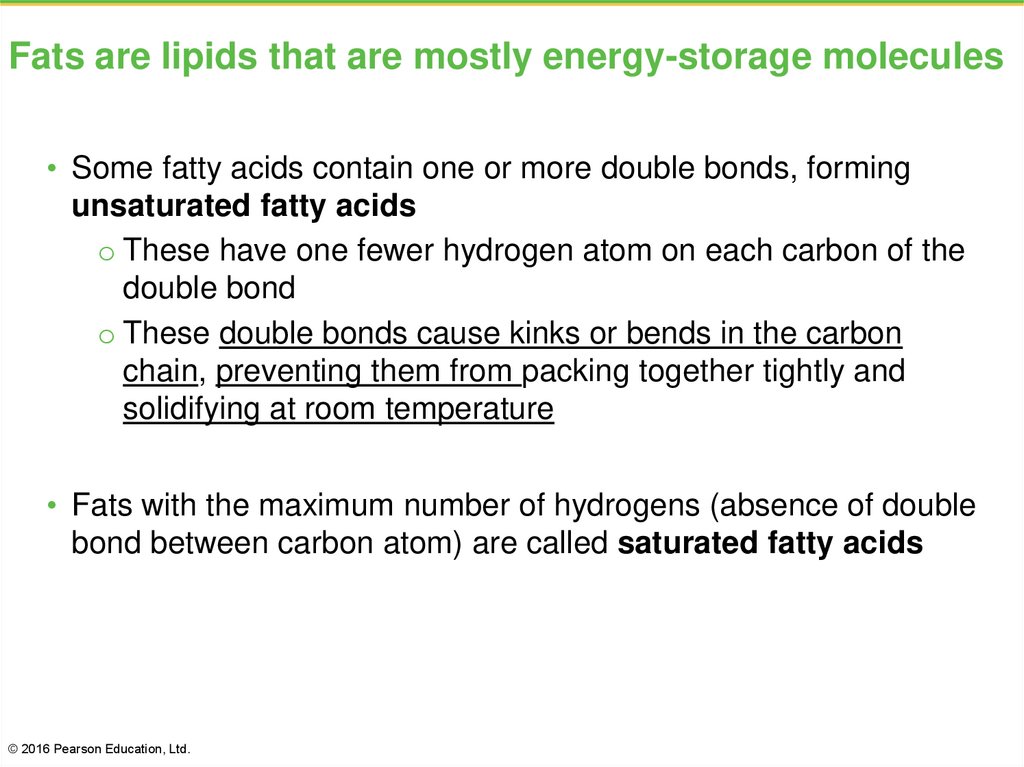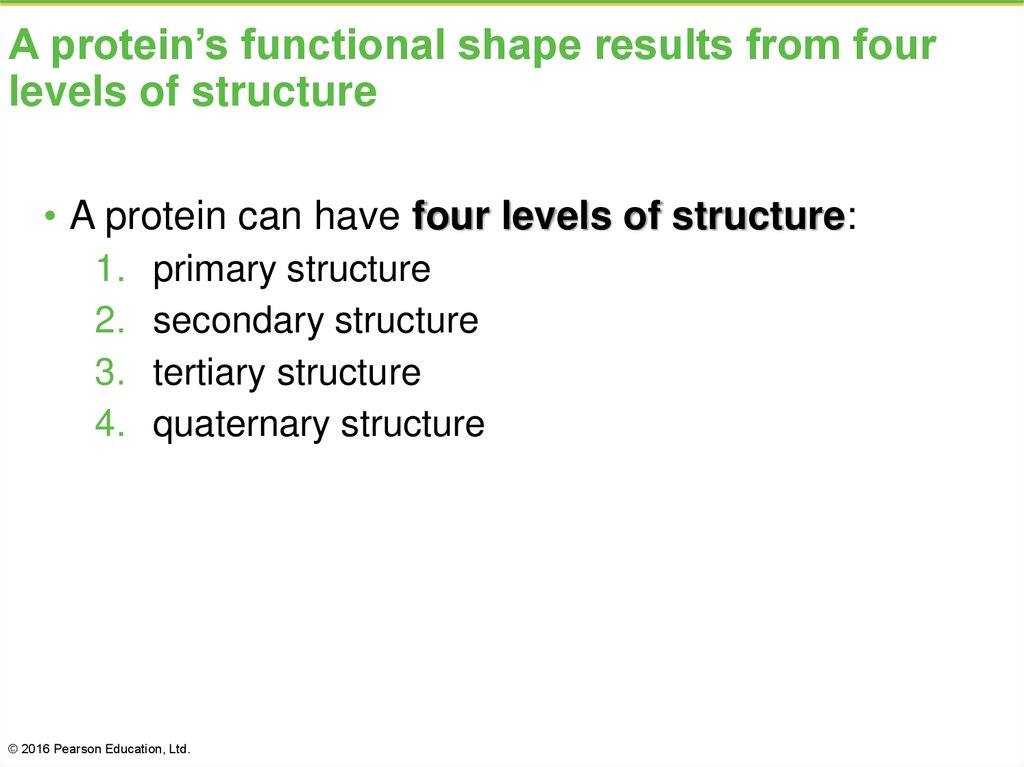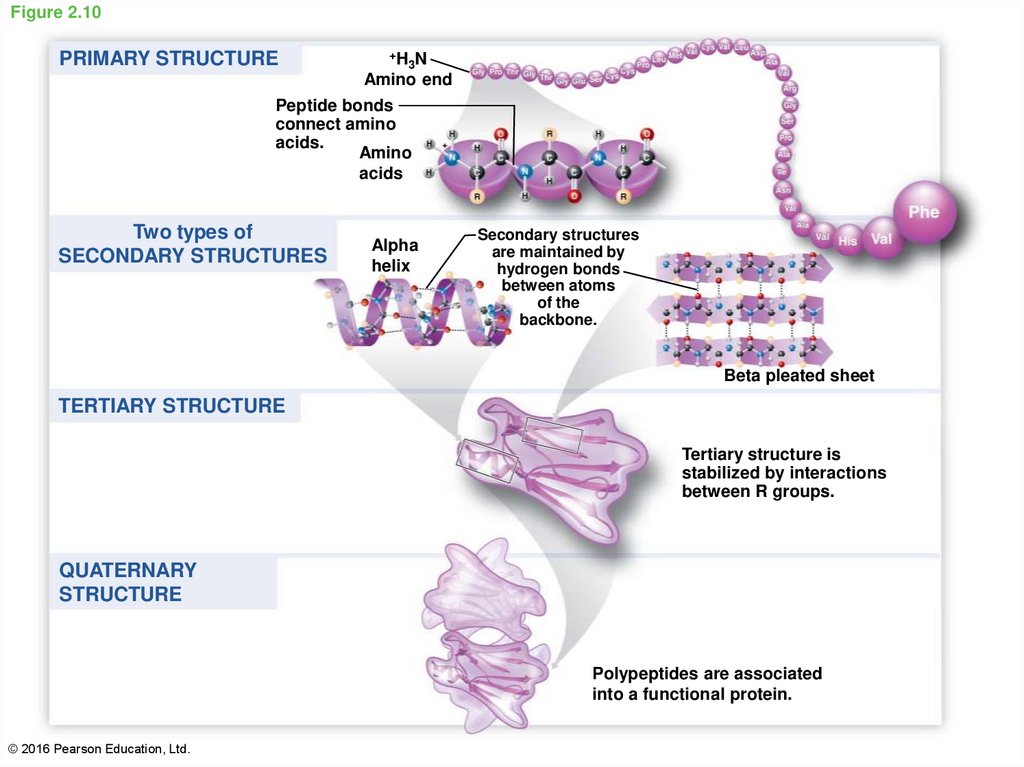Similar presentations:
The Molecules of Life
1. 2_ The Molecules of Life
Introduction to Organic CompoundsCarbohydrates
Lipids
Proteins
Nucleic Acids
© 2016 Pearson Education, Ltd.
2. After completing this topic, you should be able to:
1.Describe the importance of carbon to life’s molecular diversity.
2.
Define isomers
3.
Define macromolecules, monomer and polymer.
4.
Compare dehydration and hydrolysis reactions.
5.
Explain how a cell can make a variety of large molecules from a
small set of molecules.
6.
Define monosaccharides, disaccharides, and polysaccharides and
explain their functions.
7.
Define lipids, phospholipids, and steroids and explain their functions.
8.
Describe the chemical structure of proteins and the importance of
proteins to cells.
9.
Describe the chemical structure of nucleic acids and explain how
they relate to inheritance.
© 2016 Pearson Education, Ltd.
3.
Introduction to Organic Compounds• Properties of carbon
• Functional groups
• Cells make/break large molecules
© 2016 Pearson Education, Ltd.
4. Life’s molecular diversity is based on the properties of carbon
• Almost all the molecules a cell makes are composed of carbonbonded to
o other carbons
o atoms of other elements
• Carbon-based molecules are called organic compounds
• By sharing electrons, carbon can
o bond to four other atoms
o branch in up to four directions
© 2016 Pearson Education, Ltd.
5. Hydrocarbons
• Methane (CH4)and other compounds composed of only carbonand hydrogen are called hydrocarbons
• Carbon, with attached hydrogens, can form chains of various
lengths
• A carbon skeleton is a chain of carbon atoms that can differ in
length and be
o straight
o branched
o arranged in rings
© 2016 Pearson Education, Ltd.
6. Figure 2.1b
Double bondEthane
Propane
Length: Carbon skeletons vary
in length.
Butane
Iso-butane
Branching: Carbon skeletons may
be unbranched or branched.
© 2016 Pearson Education, Ltd.
1-Butene
2-Butene
Double bonds: Carbon skeletons may have
double bonds, which can vary in location.
Cyclohexane
Benzene
Rings: Carbon skeletons may be arranged in
rings. (In the abbreviated ring structures, each
corner represents a carbon and its attached
hydrogens.)
7. Isomers
• Compounds with the same formula but different structuralarrangements are called isomers
Butane
© 2016 Pearson Education, Ltd.
Iso-butane
8. Functional Groups: A few chemical groups are key to the functioning of biological molecules
• The unique properties of an organic compound depend ono the size and shape of its carbon skeleton
o the groups of atoms that are attached to that skeleton
• The sex hormones testosterone and estradiol (a type of
estrogen) differ only in the groups of atoms highlighted below
Male hormone
© 2016 Pearson Education, Ltd.
Female hormone
9. Table 2.2
• The first five groups are calledfunctional groups; they affect a
molecule’s function in a
characteristic way
• These five groups are polar, so
compounds containing them are
typically hydrophilic (waterloving) and soluble in water
• A sixth group, the methyl group
o consists of a carbon bonded
to three hydrogen atoms
o is nonpolar and not reactive
o still affects molecular shape
and thus function
© 2016 Pearson Education, Ltd.
10. Cells make large molecules from a limited set of small molecules
• There are four classes of molecules important to organisms:1.
2.
3.
4.
carbohydrates
lipids
proteins
nucleic acids
© 2016 Pearson Education, Ltd.
11.
• The four classes of biological molecules contain very largemolecules
o They are often called macromolecules because of their
large size
o They are also called polymers because they are made from
identical or similar building blocks strung together
o The building blocks of polymers are called monomers
© 2016 Pearson Education, Ltd.
12. Dehydration and Hydrolysis
• Monomers are linked together to form polymers through dehydrationreactions, which remove water
• Polymers are broken apart by hydrolysis, the addition of water
• These reactions are mediated by enzymes, specialized macromolecules that
speed up chemical reactions in cells
• A cell makes a large number of polymers from a small group of monomers
For example,
o Proteins are made from 20 different amino acids
o DNA (nucleic acids) is built from 4 kinds of monomers called
nucleotides
© 2016 Pearson Education, Ltd.
13. Figure 2.3-1
Unlinkedmonomer
Short polymer
Dehydration reaction
forms a new bond
Longer polymer
© 2016 Pearson Education, Ltd.
H2O
14. Figure 2.3-2
H2OHydrolysis
breaks a bond
© 2016 Pearson Education, Ltd.
15.
Carbohydrates• Monosaccharide
• Disaccharide
• Polysaccharide
© 2016 Pearson Education, Ltd.
16. Monosaccharides: the simplest carbohydrates
• Carbohydrates range from small sugar molecules (monomers)to large polysaccharides
• Sugar monomers are monosaccharides, such as those found in
o fructose
o glucose
o Honey (mixture of different compounds with
monosaccharides being the major component)
© 2016 Pearson Education, Ltd.
17.
Monosaccharides can be hooked together by dehydrationreactions to form
o more complex sugars
o Polysaccharides
The carbon skeletons of monosaccharides vary in length
o Glucose and fructose are six carbons long
o Others have three to seven carbon atoms
Monosaccharides are
o the main fuels for cellular work
o used as raw materials to manufacture other organic
molecules
© 2016 Pearson Education, Ltd.
18.
Isomers• Many monosaccharides form rings
• The ring diagram may be
o abbreviated by not showing the
carbon atoms at the corners of
the ring
Glucose
Fructose
Simplified structure
Structural formula
Abbreviated structure
© 2016 Pearson Education, Ltd.
19. Two monosaccharides are linked to form a disaccharide
• Two monosaccharides(monomers) can bond to form a
disaccharide in a dehydration
reaction
• The disaccharide sucrose is
formed by combining
o a glucose monomer
o a fructose monomer
Glucose
Glucose
H2O
• The disaccharide maltose is
formed from two glucose
monomers
Maltose
© 2016 Pearson Education, Ltd.
20. Polysaccharides:
• Polysaccharides are macromolecules, polymers composed ofthousands of monosaccharides
• Polysaccharides may function as
o storage molecules
o structural compounds
• Polysaccharides are usually hydrophilic (water-loving)
• Bath towels, for example, are often made of cotton, which is
mostly cellulose, and therefore water absorbent
© 2016 Pearson Education, Ltd.
21. Polysaccharides are long chains of sugar units
• Starch iso composed of glucose monomers
o used by plants for energy storage
• Glycogen is
o composed of glucose monomers
o used by animals for energy storage
• Cellulose
o is a polymer of glucose monomers
o forms plant cell walls
• Chitin is
o used by insects and crustaceans to build an exoskeleton, and
found in the cell walls of fungi
© 2016 Pearson Education, Ltd.
22. Figure 2.6
Starch, glycogen, and cellulose are glucose polymersStarch granules in
a potato tuber cell
Glycogen granules
in muscle
tissue
Cellulose microfibrils
in a plant cell wall
Cellulose
molecules
© 2016 Pearson Education, Ltd.
Starch
Glucose
monomer
Glycogen
Cellulose
Hydrogen bonds
23.
Lipids• Fats
• Phospholipids
• Steroids
© 2016 Pearson Education, Ltd.
24. Lipids
o are water insoluble (hydrophobic, or water-fearing) compoundso are important in long-term energy storage
o contain twice as much energy as a polysaccharide
o consist mainly of carbon and hydrogen atoms linked by nonpolar covalent
bonds
• Lipids differ from carbohydrates, proteins, and nucleic acids in that they are
o not huge molecules
o not built from monomers
• Lipids vary a great deal in structure and function
• We will consider three types of lipids:
1. fats
2. phospholipids
3. steroids
© 2016 Pearson Education, Ltd.
25. Fats
• A fat is a large lipid made from two kinds of smaller molecules:o glycerol
o fatty acids
• A fatty acid can link to glycerol by a dehydration reaction
• A fat contains one glycerol linked to three fatty acids - are
often called triglycerides
© 2016 Pearson Education, Ltd.
Saturated fats
Unsaturated fats
26. Figure 2.7a
GlycerolH2O
Fatty acid
© 2016 Pearson Education, Ltd.
27. Fats are lipids that are mostly energy-storage molecules
• Some fatty acids contain one or more double bonds, formingunsaturated fatty acids
o These have one fewer hydrogen atom on each carbon of the
double bond
o These double bonds cause kinks or bends in the carbon
chain, preventing them from packing together tightly and
solidifying at room temperature
• Fats with the maximum number of hydrogens (absence of double
bond between carbon atom) are called saturated fatty acids
© 2016 Pearson Education, Ltd.
28.
• Unsaturated fats are referred to as oils• Most animal fats are saturated fats
• Hydrogenated vegetable oils are unsaturated fats that have been
converted to saturated fats by adding hydrogen
• This hydrogenation creates trans fats, which are associated with
health risks
Unsaturated fat is a healthier fat compared to saturated fat, while trans
fats is the unhealthiest fat
© 2016 Pearson Education, Ltd.
29. Phospholipids
Fat• Phospholipids are the major
component of ALL cell
membranes
• Phospholipids are structurally
similar to fats
o Fats contain three fatty
acids attached to glycerol
o Phospholipids contain two
fatty acids attached to
glycerol
© 2016 Pearson Education, Ltd.
Phospholipid
30. Figure 2.8a
Phosphategroup
Glycerol
Hydrophilic heads Water
Hydrophobic tails
Symbol for phospholipid
Water
• Phospholipids cluster into a bilayer of phospholipids
• The hydrophilic heads are in contact with
o the water of the environment
o the internal part of the cell
• The hydrophobic tails cluster together in the center of
the bilayer
© 2016 Pearson Education, Ltd.
31. Steroids are important lipids with a variety of functions
• Steroids are lipids in which the carbon skeleton contains fourfused rings
• Cholesterol is
o a common component in animal cell membranes
o a starting material for making steroids, including sex
hormones
Figure 2.9
© 2016 Pearson Education, Ltd.
32.
PROTEINS© 2016 Pearson Education, Ltd.
33. Proteins
• Proteins areo involved in nearly every dynamic function in your body
o very diverse, with tens of thousands of different proteins,
each with a specific structure and function, in the human
body
• Proteins are composed of differing arrangements of a common
set of just 20 amino acid monomers
• Probably the most important role for proteins is as enzymes,
proteins that
o serve as catalysts
o regulate virtually all chemical reactions within cells
© 2016 Pearson Education, Ltd.
34. Types of Proteins
• Besides enzymes, other types of proteins includeo transport proteins embedded in cell membranes, which
move sugar molecules and other nutrients into your cells
o defensive proteins, such as antibodies of the immune
system
o signal proteins such as many hormones and other chemical
messengers that help coordinate body activities
o receptor proteins, built into cell membranes, which receive
and transmit signals into your cells
o contractile proteins found within muscle cells
o structural proteins such as collagen, which form the long,
strong fibers of connective tissues
o storage proteins, which serve as a source of amino acids
for developing embryos in eggs and seeds
© 2016 Pearson Education, Ltd.
35.
• The functions of different types of proteins depend on theirindividual shapes
• The shape of a protein is the result from 4 level of structures
• Protein is a polypeptide chain contains hundreds or thousands
of amino acids linked by “peptide bonds”
• Changes in protein shapes (damage of the secondary, tertiary
and quaternary structures), referred as the “denaturation”
process results in protein malfunction
• Proteins can be denatured by changes in salt concentration,
changes in pH, or high heat
© 2016 Pearson Education, Ltd.
36. Proteins are made from amino acids linked by peptide bonds
• Amino acids all haveo an amino group
o a carboxyl group (which makes it an acid)
• Also bonded to the central carbon is
o a hydrogen atom
o a chemical group symbolized by R, which determines the
specific properties of each of the 20 amino acids used to
make proteins
Amino
group
© 2016 Pearson Education, Ltd.
Carboxyl
group
37.
• Amino acid monomers are linked together in a dehydrationreaction
• the carboxyl group of one amino acid is joined to the amino
group of the next amino acid, and creating a peptide bond
• Additional amino acids can be added by the same process to
create a chain of amino acids called a polypeptide
Carboxyl
group
Amino acid
© 2016 Pearson Education, Ltd.
Amino
group
Amino acid
Peptide bond
Dehydration
reaction
H2O
Dipeptide
38. A protein’s functional shape results from four levels of structure
• A protein can have four levels of structure:1.
2.
3.
4.
primary structure
secondary structure
tertiary structure
quaternary structure
© 2016 Pearson Education, Ltd.
39. Figure 2.10
PRIMARY STRUCTURE+H N
3
Amino end
Peptide bonds
connect amino
acids.
Amino
acids
Two types of
SECONDARY STRUCTURES
Alpha
helix
Secondary structures
are maintained by
hydrogen bonds
between atoms
of the
backbone.
Beta pleated sheet
TERTIARY STRUCTURE
Tertiary structure is
stabilized by interactions
between R groups.
QUATERNARY
STRUCTURE
Polypeptides are associated
into a functional protein.
© 2016 Pearson Education, Ltd.
40.
NUCLEIC ACIDS© 2016 Pearson Education, Ltd.
41. DNA and RNA are the two types of nucleic acids
• The amino acid sequence of a polypeptide is programmed by adiscrete unit of inheritance known as a gene
• Genes consist of DNA (deoxyribonucleic acid), a type of
nucleic acid
• DNA is inherited from an organism’s parents
• DNA provides directions for its own replication
• DNA programs a cell’s activities by directing the synthesis of
proteins
• DNA does not build proteins directly
• DNA works through an intermediary, RNA (ribonucleic acid).
• DNA is transcribed into RNA in a cell’s nucleus
• RNA is translated into proteins in the cytoplasm
© 2016 Pearson Education, Ltd.
42. Figure 2.11-1
GeneDNA
Nucleic acids
Transcription
RNA
Translation
Amino
acid
© 2016 Pearson Education, Ltd.
Protein
43. Nucleic acids are polymers of nucleotides
• DNA (deoxyribonucleic acid) and RNA (ribonucleic acid) arecomposed of monomers called nucleotides
• Nucleotides have three parts:
1. a five-carbon sugar called ribose in RNA and deoxyribose
in DNA
2. a phosphate group
3. a nitrogenous base
• DNA nitrogenous bases are
o adenine (A)
o thymine (T)
o cytosine (C)
o guanine (G)
• RNA also has A, C, and G, but instead of T, it has uracil (U)
© 2016 Pearson Education, Ltd.
44.
• A nucleic acid polymer, a polynucleotide, forms from thenucleotide monomers when the phosphate of one nucleotide
bonds to the sugar of the next nucleotide by dehydration
reactions.
• This produces a repeating sugar-phosphate backbone
with protruding nitrogenous bases.
Nucleotide
Sugar-phosphate
backbone
© 2016 Pearson Education, Ltd.
45.
• RNA is usually a single polynucleotidestrand
• DNA is a double helix, in which two
polynucleotide strands wrap around
each other
• The two strands are associated
because particular bases always
hydrogen-bond to one another
• A pairs with T, and C pairs with G,
producing base pairs
C
C
G
G
T
A
C
G
A
Base
pair
A
T
G
C
A
A
T
© 2016 Pearson Education, Ltd.
T
A
T
T













































 chemistry
chemistry








